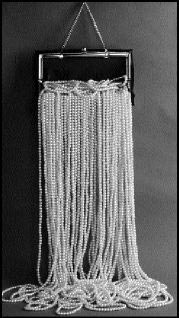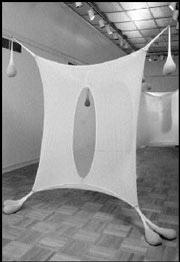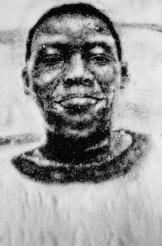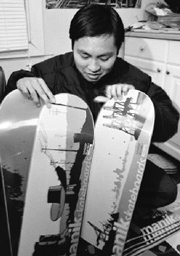KUSTOM PURSE
Kuhlman, 2419 First, 441-1999 10 a.m.-7 p.m. Mon.-Sat.; noon-5 p.m. Sun. ends Mon., Dec. 31
SHOPPING
Vital 5, 2200 Westlake, 254-0475 noon-5 p.m. Sat.-Sun., Dec. 15-16 and Dec. 22-23 “Simulate the Economy” Party 5-10 p.m. Sat., Dec. 15
FOR MOST ARTISTS, yuletide is a round of seasonal auctions, craft sales, and open studios. But this year, several shows are seizing the moment to critique the whole idea of art-as-fashion and art-as-commodity. Yet, despite the slant of their pieces, many—from handbags to installations—are actually selling.
“Kustom Purse” is curated by artist Elizabeth Jameson at the Belltown menswear emporium Kuhlman. The shop, started by ex-sculptor Scott Kuhlman, stages art shows every three months. For the Thanksgiving-Christmas project, Jameson asked 30 artists to create “their kind of purses.”
Many contributors are guerrilla types from Soil or Fuzzy Engine; others are represented by straighter, Pioneer Square galleries. Yet almost all their works make some reference to mainstream retail. Money Bag by Gabriel Stewart is made out of dollar bills; a boxy purse by Jennifer West features a tiny inset TV screen (embedded in a black, mock-croc surface, it unreels a loop of struggling, trapped insects). Katy Stone’s French Poodle purse, sculptured out of teal-colored pipe cleaners, parodies the retro swirl of 1950s fashion typography. There is even one vinyl handbag (by Jesse P. Miller and Linda Peschong) filled with “shoplifted sounds”: ambient noise “stolen” from inside a range of local stores.
The purses are displayed without price tags, just as art. Yet, says Kuhlman, they have been selling well, at sums between $50 and $300. “Mostly, they’re some kind of comment on materialism,” says Kuhlman. “But lots of people who shop here prefer to buy one of a kind.” Recently, Kuhlman had to replace several purses because out-of-town buyers carted them away.
For replacements, Kuhlman called on artist Jennifer Shontz, requesting two purses from her “Changing My Mind” show, which was held at Pioneer Square’s Mary Vitold Gallery last month. Four of the most striking works in that exhibition used purses as a base for “small cartoons about generosity.” “Generosity,” Shontz says, “is a skill you have to practice. I wanted to enhance that in my life, to begin expressing a feeling of abundance.” To work with, she chose patent leather purses, stuffing them with explosive amounts of carefully polished Asian rice, hand-lacquered black beans, and luxurious strings of pearls. Two of these purses are now on show at Kuhlman, priced at $300 and $350.
BLOCKS AWAY, another Christmas show echoes similar themes—this time, debunking concepts such as “branding” and corporate fashion. The show is “Shopping” at Vital 5 Productions, a set of installations about salesmanship and acquisitiveness.
“Shopping” bills itself as “everything you never needed.” Yet its nine-hour opening brought in families, teens, and tourists as well as gallerygoers. What they got was a parody of both the boutique and the museum gift shop. Set up as a mini-trade fair for fictitious labels, “Shopping” was put together by artists and actors, helped by translators, filmmakers, and accountants.
Sculptor Jennifer McNeely, for example, created both a label (“Moxie Unlimited”) and its customized sales station. As with “Kustom Purse,” actual sales have been surprisingly brisk. But who could resist a product line such as “Moxie”: well-packaged miniversions of McNeely’s fabric sculptures? Her signature works are made from silk stockings—stretched, twisted, then hand sewn into quasi-sexual shapes. Yet children and teens are mobbing her counter, handing over dollar bills for what she now calls Nubs and Toobs.
Another crowd favorite is Greg Lundgren’s “Rich American”: clothing with giant logos sewn right through each garment. (“You’re so rich,” read the tags, “you can leave it on the hanger!”). “Rich American” features shoes sprayed solid gold for $700 as well as $250 shirts and $30 Evian-style bottles of crude oil. Says Lundgren, “It’s a completely dysfunctional label; our only item that could possibly sell is a T-shirt. But that’s because we’re a spoof on the likes of Chanel. You know, no one can really buy Chanel. So, would-be Rich Americans buy Chanel T-shirts.”
Other folks throw similar curveballs at capitalism. P.A.N.-L.A.B. Industries has mounted a line of sunglasses, T-shirts, and fake designer drugs—including a timely $10-per-pack omni-depressant. Dylan Neuwirth’s “Resist” sells wax cell phones ($10), paper suits ($50-100), and styrofoam briefcases ($25). Says Lundgren, who is Vital 5’s proprietor, “Jen McNeely probably topped out with sales. But people are buying a lot of stuff, and most of it is pretty conceptual.”
“Le Oui,” a line of beauty potions by Not Bad for a Girl Productions, has sold more than three dozen bottles—with labels such as Walk Home Safe or Bosom Glance Deflector—for $3 each. At their powder-pink booth, the company’s infomercial is running, complete with cheesy graphics and dewy-eyed testimonials. Says one of the brand’s eight spokesmodels, Iris Stevenson, “Most buyers are girls, and their favorite is Ex-Boyfriend Relocator.”
What is really on sale at “Shopping” and “Kustom Purse” is a change of perspective. But putting the artists’ take on luxury into a retail mainstream has unexpected, somewhat ironic, results. Or as one well-heeled “Shopping” buyer whispered to his spouse, “This is a long way from Linda Farris. But it’s more fun!”







